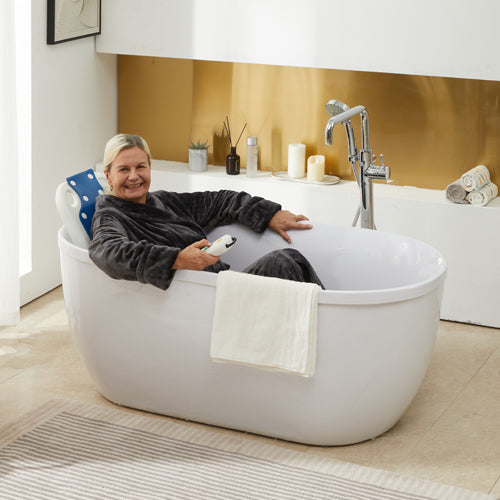A lift chair is an essential piece of equipment for people with limited mobility. It is a motorized recliner that helps the user easily transition from sitting to a standing position. Helping to increase the independence of people with limited mobility due to age, injury, or illness, it also reduces the risk of falls and injuries associated with getting up from a traditional chair.
Recognizing the role that lift chairs play in improving the quality of life for people with mobility impairments, Medicare provides coverage under its Durable Medical Equipment (DME) provisions (specifically Medicare Part B). Understanding Medicare's role in facilitating access to mobility aids such as lift chairs can help eligible beneficiaries understand the process of obtaining a lift chair and ensure that they get the help they need without incurring the full cost.
What Is a Lift Chair?
A lift chair is a recliner that helps the user transition from a sitting to a standing position. Lift chairs are especially suited for people with mobility issues or those who have difficulty standing from a seated position due to age, injury, or illness. Moreover, lift chairs are motorized and can be controlled by a simple remote control that allows the user to adjust the chair to various positions for maximum comfort. In addition, many types of lift chairs offer features such as heat, massage, and multiple reclining positions to enhance user relaxation and support.

Benefits of Lift Chairs?
Lift chairs offer a variety of benefits that can significantly enhance the quality of life for individuals, especially those with mobility challenges. Here are some key advantages:
-
Enhanced Mobility: Lift chairs help users easily transition from sitting to standing, which is particularly beneficial for those with arthritis, back pain, or conditions that impair strength and balance.
-
Increased Independence: By allowing users to sit and stand without assistance, lift chairs foster greater independence and self-reliance.
-
Reduced Risk of Injury: The controlled movement reduces the strain on muscles and joints, minimizing the risk of falls and injuries associated with attempting to stand from a low position.
-
Comfort and Support: Lift chairs are designed to provide superior comfort and support. They often come with multiple reclining options to relieve pressure on the back and legs, and some models include features like heating and massage to further enhance comfort.
-
Versatility: These chairs can be used for sitting, sleeping, or just relaxing, with adjustments available for different positions to accommodate various activities like reading, watching TV, or napping.
-
Customizable Options: Many lift chairs come with a range of upholstery choices and styles to match the home decor, along with different sizes to fit various body types and weights.
A lift chair is a great addition to the home for anyone who needs assistance sitting or standing, providing comfort and promoting autonomy while reducing the risk of falls and stress on the body.
Medicare Coverage for Lift Chairs
Medicare Part B can help cover the cost of a lift chair, but it's important to understand the specifics of this coverage. Medicare typically covers the lifting mechanism of the chair, not the entire chair itself. This means that the motorized part of the lift chair that assists a person in standing up from a seated position is covered, while the furniture component of the chair (such as the upholstery, frame, and cushions) is not.
Here are some key points about Medicare coverage for lift chairs:
-
Qualification Criteria: To qualify for coverage, a doctor must prescribe the lift chair as necessary due to a specific medical condition (like severe arthritis or other mobility issues).
-
Medicare Part B: The lifting mechanism is considered durable medical equipment (DME) under Medicare Part B. If you meet the coverage criteria, Medicare Part B will cover 80% of the approved amount for the lift mechanism after you have met your deductible.
-
Reimbursement Process: You are typically responsible for paying the full cost upfront, and Medicare will reimburse you for its share of the lift mechanism cost.
-
Supplier Requirements: It's essential to purchase the lift chair through a supplier that is enrolled in Medicare for you to receive any coverage benefits.
-
Additional Insurance: If you have a Medigap (Medicare Supplement Insurance) policy, it may cover the remaining 20% of the cost that Medicare does not cover.
It is recommended to contact a Medicare representative directly or check the official Medicare website to get the most accurate and up-to-date information for your situation. This will help ensure that you are aware of all the requirements and necessary steps to potentially receive coverage for a lift chair.
How to Get a Lift Chair Through Medicare?
To get a lift chair through Medicare, you'll need to follow several important steps to ensure that part of the cost is covered under Medicare Part B, which treats the mechanism of a lift chair as durable medical equipment (DME). Here's how you can proceed:
-
Consult with your doctor: The first step is to discuss your mobility issues with your doctor or healthcare provider. Medicare requires your doctor to prescribe a chair lift. Your doctor must certify that the chair lift will help you with a medical condition, such as severe arthritis or other mobility problems that prevent you from getting up from a regular chair.
-
Ensuring Medical Necessity: Your doctor must provide documentation that you have a medical need for a lift chair, including the inability to get up from a regular chair without help. The documentation should also show that you can operate the chair independently and that the chair is very helpful for the specific medical condition.
-
Find a Medicare-approved supplier: Purchase your lift chair from a Medicare-enrolled supplier. Medicare covers any portion of the cost. You can find an approved supplier through the Medicare website or by contacting Medicare directly.
-
Submit a claim: After you purchase a lift chair, submit a claim to Medicare for the lift device. Generally, Medicare covers 80% of the approved amount for the lift after you meet your Part B deductible. You are responsible for paying the remaining 20% unless you have supplemental coverage such as Medigap.
-
Keep all receipts and documentation: Make sure you keep all receipts and documentation related to the purchase of your lift and any communication with your healthcare provider about the medical necessity of your lift. These documents are important for Medicare to process your claim.
It is recommended to contact Medicare or check their website for the latest information on coverage and any updates to requirements for durable medical equipment such as lift chairs. Medicare's contact information and more detailed guidelines can be found directly on their official website.
Is the Lift Chair Covered by Medical Insurance?
Each country has different policies on whether medical insurance covers chair lifts. In the United States, health insurance may cover a chairlift, but coverage is usually limited to the cost of the lift mechanism, not the entire chairlift. A doctor's certification is required to explain the medical need for the lift mechanism to help patients stand up and sit down.
On the other hand, it is recommended to check with insurance companies and providers before purchasing to ensure that the lift chair you purchase qualifies for insurance reimbursement. At the same time, VOCIC is actively promoting our medical insurance policies. Please stay tuned for updates as our information will be synced on our website and social media.

Conclusion
This article provides a comprehensive overview of the benefits of lift chairs for people with mobility impairments and the process of obtaining a lift chair through Medicare. In addition to Medicare-covered lift chairs, there are many popular brands of lift chairs on the market. For example, VOCIC is actively promoting Medicare coverage policies, and VOCIC also offers other mobility aids such as scooters and wheelchairs, so please visit our website if you need one.







